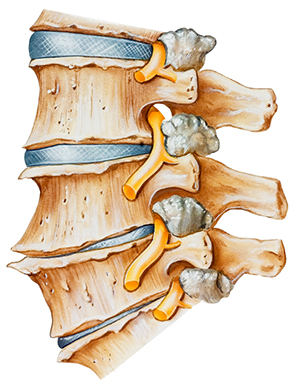Almost everybody that has experienced or knows somebody that has chronic back pain has heard the term “degenerative disc disease”. Many see this as a diagnosis or problem that is causing symptoms. As chiropractors, we see this as a symptom to the real, underlying problem.
The term can be somewhat confusing. Many people are told that degenerative disc disease is a normal process that occurs in your spine naturally as your body ages. However, if this were true we would expect to see it throughout the spine, not just in specific areas. In most cases it is seen only in one or two discs but may progress to the ones above and below if nothing is done to correct the problem causing it.
The discs in your spine create the joints between the vertebral bodies. They are made up of the nucleus, that is similar to a gel like substance, that is surrounded by annulus, or criss crossed, fibers. Healthy discs are thick and soft while unhealthy discs become thinner and brittle as the degenerative process occurs. This happens in two different ways, either too much motion or not enough. When a vertebra is subluxated, or not moving like it should, the disc does not move like it should either. Normally, movement in the vertebra will create a pumping action in the disc that draws in and pushes out fluid. This acts to bring nutrients into the disc due to the lack of blood supply to the disc. When a disc is not “pumping” like it should, the amount of fluid inside is reduced and it begins to dehydrate causing cracks and tears in the annulus fiber of the disc. Eventually the disc will begin to get thinner and thinner as time goes on and possibly result in bulging or herniation.
A disc can also be damaged and begin to degenerate when there is too much motion or stress placed on the disc. As mentioned earlier, if one vertebra is not moving as much as it should that means that there are others that are moving too much to make up for it. This hypermobility in the joint creates stress on the disc which causes wear and tear. This leads to damage of the disc which results in degeneration of the disc as well as the possibility of bulging, rupture or herniation of the disc. So if we have dysfunction or subluxations in the spine causing these problems they will continue to progress as we get older if not properly treated. This is why many people associate disc degeneration with age.
Stages of Disc Degeneration
As Gonstead Chiropractors, we use a system to classify the stages of disc degeneration into six categories:
D1 – Swollen Disc
The entire disc becomes noticeably thicker and more swollen from an acute injury. It is obviously thicker than the other discs in its area of the spine.
D2 – Disc Thin at Posterior
The posterior part of the disc is slightly diminished, with the vertebra just noticeably misaligned. At this stage the disc has proceeded beyond the acute phase.
D3 – Disc Very Thin at Posterior
The posterior part of the disc is extremely diminished, the body becoming more noticeably misaligned. This is a chronic state.
D4 – Total disc is Thin
The total thickness of the disc is noticeably diminished, and may be reduced to about two-thirds of its original height. The vertebra is misaligned. There is minimal damage to the vertebral body above the disc, with some evidence of arthritis or bony formation. This condition has become more chronic than that above.
D5 – Total Disc Very Thin
The total disc is decreased to about one-third of its original thickness. The vertebra has become very misaligned. There is severe damage to the body of the vertebra above, and well advanced arthritis and bony formation. This is a much more chronic condition.
D6 – Total Disc is Extremely Thin
The entire disc spacing is extremely diminished, from two-thirds to totally reduced. The vertebra is extremely misaligned. This is the most chronic condition.
Most people will begin to experience pain when a disc has reached a D2 or D3 level, however, some people will go even longer without any pain not realizing they have a growing problem in their spine. Although it is better to get treatment when a disc is at a D1 Stage, we are able to treat most people at any stage of disc degeneration.
Can I benefit from Chiropractic Care if I Have Degenerative Disc Disease?
Whether you are experiencing pain or not, it is a good idea to see your chiropractor. Chiropractors are trained to examine how each vertebrae is moving and make the necessary corrections to prevent the degenerative process. Chiropractic care generally focuses on addressing back pain at its source as well as improving the spine’s stability and mobility. Although there is no way to completely reverse the changes in the disc caused by degenerative disc disease, chiropractic adjustments can help minimize its impact as well as keep it from progressing further by restoring the correct bio-mechanical motion in your spine. If you would like to find out if chiropractic care in Tulsa could help you or someone you care about, please call our office today at (918) 664-3571 to schedule a consultation.






